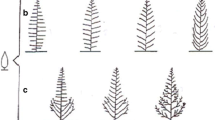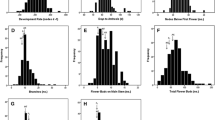Abstract
In this study, we mapped the diplosporous chromosomal region in Taraxacum officinale, by using amplified fragment length polymorphism technology (AFLP) in 73 plants from a segregating population. Taraxacum serves as a model system to investigate the genetics, ecology, and evolution of apomixis. The genus includes sexual diploid as well as apomictic polyploid, mostly triploid, plants. Apomictic Taraxacum is diplosporous, parthenogenetic, and has autonomous endosperm formation. Previous studies have indicated that these three apomixis elements are controlled by more than one locus in Taraxacum and that diplospory inherits as a dominant, monogenic trait (Ddd; DIP). A bulked segregant analysis provided 34 AFLP markers that were linked to DIP and were, together with two microsatellite markers, used for mapping the trait. The map length was 18.6 cM and markers were found on both sides of DIP, corresponding to 5.9 and 12.7 cM, respectively. None of the markers completely co-segregated with DIP. Eight markers were selected for PCR-based marker development, of which two were successfully converted. In contrast to all other mapping studies of apomeiosis to date, our results showed no evidence for suppression of recombination around the DIP locus in Taraxacum. No obvious evidence for sequence divergence between the DIP and non-DIP homologous loci was found, and no hemizygosity at the DIP locus was detected. These results may indicate that apomixis is relatively recent in Taraxacum.




Similar content being viewed by others
References
Albertini E, Porceddu A, Ferranti F, Reale L, Barcaccia G, Romano B, Falcinelli M (2001) Apospory and parthenogenesis may be uncoupled in Poa pratensis: a cytological investigation. Sex Plant Reprod 14:213–217
Bicknell RA, Borst NK, Koltunow AM (2000) Monogenic inheritance of apomixis in two Hieracium species with distinct developmental mechanisms. Heredity 84:228–237
Birky CW Jr. (1996) Heterozygosity, heteromorphy, and phylogenetic trees in asexual eukaryotes. Genetics 144:427–437
Brugmans B, Van der Hulst R, Visser RGF, Lindhout P, Van Eck HJ (2003) A new and versatile method for the successful conversion of AFLP markers into simple single locus markers. Nucleic Acids Res 31:e55
Grimanelli D, Leblanc O, Espinosa E, Perotti E, De Leon DG, Savidan Y (1998) Mapping diplosporous apomixis in tetraploid Tripsacum: one gene or several genes? Heredity 80:33–39
Grossniklaus U (2001) From sexuality to apomixis: molecular and genetic approaches. In: Savidan Y, Carman JG, Dresselhaus T (eds) The flowering of apomixis: from mechanism to genetic engineering. European Commission DG VI (FAIR), pp168–211
Grossniklaus U, Nogler GA, Van Dijk PJ (2001) How to avoid sex: the genetic control of gametophytic apomixis. Plant Cell 13:1491–1497
Gustafsson Å (1934) Primary and secondary association in Taraxacum. Hereditas 20:1–31
Gustine DL, Sherwood RT, Huff DR (1997) Apospory-linked molecular markers in buffalograss. Crop Sci 37:947–951
Juel O (1900) Vergleichende Untersuchungen über typische und parthenogenetische Fortpflanzung bei der Gattung Antennaria. K Sven Vetenskapsakad Handl 33:1–59
Juel O (1906) Die Tetradenteilung bei Taraxacum und anderen Cichorieen. K Sven Vetenskapsakad Handl 39:1–21
Koltunow AM (1993) Apomixis - embryo sacs and embryos formed without meiosis or fertilization in ovules. Plant Cell 5:1425–1437
Kondrashov AS (1982) Selection against harmful mutations in large sexual and asexual populations. Genet Res 40:325–332
Labombarda P, Busti A, Caceres ME, Pupilli F, Arcioni S (2002) An AFLP marker tightly linked to apomixis reveals hemizygosity in a portion of the apomixis-controlling locus in Paspalum simplex. Genome 45:513–519
Leblanc O, Grimanelli D, Gonzalez de Leon D, Savidan Y (1995) Detection of the apomictic mode of reproduction in maize-Tripsacum hybrids using maize RFLP markers. Theor Appl Genet 90:1198–1203
Matzk F, Meister A, Schubert I (2000) An efficient screen for reproductive pathways using mature seeds of monocots and dicots. Plant J 21:97–108
Maynard-Smith J (1978) The evolution of sex. Cambridge University Press, Cambridge
Michelmore RW, Paran I, Kesseli RV (1991) Identification of markers linked to disease-resistance genes by bulked segregant analysis: a rapid method to detect markers in specific genomic regions by using segregating populations. Proc Natl Acad Sci USA 88:9828–9832
Muller HJ (1964) The relation between recombination to mutational advance. Mutat Res 1:2–9
Nogler GA (1984) Embryology of angiosperms. In: Johri BM (ed) Gametophytic embryogenesis. Springer, Berlin Heidelberg New York, pp 475–518
Noyes RD (2000) Diplospory and parthenogenesis in sexual x agamospermous (apomictic) Erigeron (Asteraceae) hybrids. Int J Plant Sci 161:1–12
Noyes RD, Rieseberg LH (2000) Two independent loci control agamospermy (apomixis) in the triploid flowering plant Erigeron annuus. Genetics 155:379–390
Okabe S (1932) Parthenogenesis bei Ixeris dentata. Bot Mag (Tokyo) 46:518–523
Ozias-Akins P, Roche D, Hanna WW (1998) Tight clustering and hemizygosity of apomixis-linked molecular markers in Pennisetum squamulatum implies genetic control of apospory by a divergent locus that may have no allelic form in sexual genotypes. Proc Natl Acad Sci USA 95:5127–5132
Paran I, RW Michelmore (1993) Development of reliable PCR-based markers linked to downy mildew resistance genes in lettuce. Theor Appl Genet 85:985–993
Pessino SC, Ortiz JPA, Leblanc O, Do Valle CB, Evans C, Hayward MD (1997) Identification of a maize linkage group related to apomixis in Brachiaria. Theor Appl Genet 94:439–444
Pessino SC, Evans C, Ortiz JPA, Armstead I, Do Valle CB, Hayward MD (1998) A genetic map of the apospory-region in Brachiaria hybrids: identification of two markers closely associated with the trait. Hereditas 128:153–158
Pupilli F, Labombarda P, Caceres ME, Quarin,CL, Arcioni S (2001) The chromosome segment related to apomixis in Paspalum simplex is homologous to the telomeric region of the long arm of rice chromosome 12. Mol Breed 8:53–61
Richards AJ (1986) Plant breeding systems. Chapman and Hall, London
Rogstad SH (1992) Saturated NaCl-CTAB solution as a means of field preservation of leaves for DNA analyses. Taxon 41:701–708
Savidan Y (2000) Apomixis: genetics and breeding. Plant Breed Rev 18:13–86
Sørensen T (1958) Sexual chromosome aberrants in triploid apomictic Taraxaca. Bot Tidskr 54:1–22
Spillane C, Steimer A, Grossniklaus U (2001) Apomixis in agriculture: the quest for clonal seeds. Sex Plant Reprod 14:179–187
Stearns SC (1987) The evolution of sex and its consequences. Birkhäuser, Basel
Tas ICQ, Van Dijk PJ (1999) Crosses between sexual and apomictic dandelions (Taraxacum) I: the inheritance of apomixis. Heredity 83:707–714
Van Baarlen P, Verduijn M, Van Dijk PJ (1999) What can we learn from natural apomicts? Trends Plant Sci 4:43–44
Van Dijk PJ (2003) Ecological and evolutionary opportunities of apomixis: insights from Taraxacum and Chondrilla. Philos Trans R Soc Lond B Biol Sci 358:1113–1121
Van Dijk PJ, Tas ICQ, Falque M, Bakx-Schotman T (1999) Crosses between sexual and apomictic dandelions (Taraxacum) II: the breakdown of apomixis. Heredity 83:715–721
Van Dijk PJ, Bakx-Schotman JMT (2003) Formation of unreduced megaspores (diplospory) in apomictic dandelions (Taraxacum officinale, s.l.) is controlled by a sex-specific dominant locus. Genetics (in press)
Vielle-Calzada JP, Crane CF, Stelly DM (1996) Apomixis: the asexual revolution. Science 274:1322–1323
Vos P, Hogers R, Bleeker M, Reijans M, Vandelee T, Hornes M, Frijters A, Pot J, Peleman J, Kuiper M, Zabeau M (1995) AFLP: A new technique for DNA-fingerprinting. Nucleic Acids Res 23:4407–4414
Welch DM, Meselson M (2000) Evidence for the evolution of bdelloid rotifers without sexual reproduction or genetic exchange. Hydrobiologia 446:333–336
Wu KK, Burnquist W, Sorrells ME, Tew TL, Moore PH, Tanksley SD (1992) The detection and estimation of linkage in polyploids using single-dose restriction fragments. Theor Appl Genet 83:294–300
Acknowledgements
This research is part of the European Union funded project: “Natural apomixis as a novel tool in plant breeding (ApoTool)”, contract number QLG2-2000-00603 of the Quality of Life and Management of Living Resources section. This paper corresponds to publication number 3225 of the Netherlands Institute of Ecology (NIOO-KNAW).
Author information
Authors and Affiliations
Corresponding author
Additional information
Communicated by C. Möllers
Rights and permissions
About this article
Cite this article
Vijverberg, K., Van der Hulst, R.G.M., Lindhout, P. et al. A genetic linkage map of the diplosporous chromosomal region in Taraxacum officinale (common dandelion; Asteraceae). Theor Appl Genet 108, 725–732 (2004). https://doi.org/10.1007/s00122-003-1474-y
Received:
Accepted:
Published:
Issue Date:
DOI: https://doi.org/10.1007/s00122-003-1474-y




